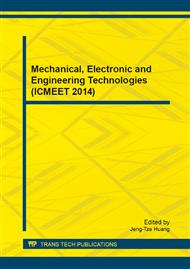[1]
Final Report of RTCA Task Force 3-Free Flight Implementation [R]. Washington DC: RTCA Inc (1995).
Google Scholar
[2]
Rick Cassell, Alex Smith, Roger Shepherd, A Risk Assessment Model for Free Flight Terminal Area Reduced Separation, Proceeding of the1996 15thAIAA/ IEEE Digital Avionics Systems Conference, Atlanta (1996), pp.73-80.
DOI: 10.1109/dasc.1996.559138
Google Scholar
[3]
Daniel Mosquera-Benitez, Alan Ross Groskreutze, Lars Fucke, Separation minima model: How change in Contributing Factors Could Affect Current Standards, Eighth USA/Europe Air Traffic Management Research and Development Seminar (ATM2009), United States (2009).
Google Scholar
[4]
Mariken H. C. Everdij, Henk A. P. Blom, Bert G. A. J. Bakker, Modeling Lateral Separation and Separation for Airborne Separation Assurance Using Petri Nets Simulation, vol. 83(2007), pp.401-414.
DOI: 10.1177/0037549706063820
Google Scholar
[5]
Zhaoning Zhang, Jinwei Shen, Jimin Liu, Lateral collision risk model based on CNS position error, Journal of Traffic and Transportation Engineering, vol. 9(2009), pp.110-113, In Chinese.
DOI: 10.1109/ccdc.2010.5498338
Google Scholar
[6]
Zhaoning Zhang, Jimin Liu, Lili Wang, Assessment of Longitudinal Collision Risk on Parallel Routes Based on Communication, Navigation and Surveillance Performances, Journal of SOUTHWEST JIAOTONG UNIVERSITY, vol. 44(2009), pp.918-925, In Chinese.
DOI: 10.1109/car.2010.5456620
Google Scholar
[7]
Jimin Liu, Zhaoning Zhang, Jinwei Shen, Assessment of Lateral Collision Risk on Parallel Routes Based on Communication, Navigation, and Surveillance Performances, Aeronautical Computing Technique, vol. 39 (2009), pp.14-18, In Chinese.
DOI: 10.1109/car.2010.5456620
Google Scholar
[8]
Ming Cai, Zhaoning Zhang, Lili Wang, Research on Collision Risk in Free Flight, Aeronautical Computing Technique, vol. 41(2011), pp.51-56, In Chinese.
Google Scholar
[9]
Zhaoning Zhang, Jiangli Zuo, Study on Free Flight Collision Risk Based ON Brownian Motion, China safety Science Journal, vol. 22(2012), pp.43-47, In Chinese.
Google Scholar
[10]
Zhaoning Zhang, Yiming Wang, Research on Collision Risk in Free Flight Based on Fuzzy Stochastic Differential Equations, China safety Science Journal, vol. 22(2012), pp.14-18, In Chinese.
Google Scholar
[11]
Zhaoning Zhang, Lili Wang, Dongbin Li, Introduction to Security Assessment on Airborne Separation, Science Press, Beijing(2009), pp.147-165, In Chinese.
Google Scholar
[12]
Doc 9869-AN/462, Manual on required communication performance (RCP), International Civil Aviation Organization, Montreal (2006).
Google Scholar
[13]
ICAO, Doc 9613-AN/937, Manual on required navigation performance[S]. Montreal: International Civil Aviation Organization, Second Edition (1999).
Google Scholar
[14]
PAVLICEVIC F, Euro control perspectives on required surveillance performance (RSP), Montreal: International Civil Aviation Organization, SASP/WG/WHL/8, WP/05(2005).
Google Scholar
[15]
Li Zhang, Shudong Huang, Aiwu He, HongYang, Human Reliability Analysis Method, China safety Science , vol. 3(2001), pp.6-15, In Chinese.
Google Scholar
[16]
G.J. (Bert) Bakker , Henk A.P. Blom, Air Traffic Collision Risk Modeling, Proceeding of the 32nd Conference on Decision Control, San Antonio(1993), pp.1464-1469.
Google Scholar


